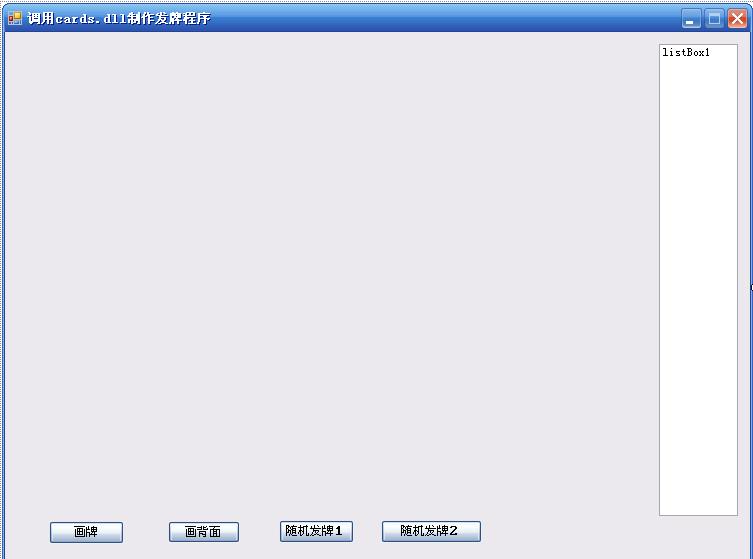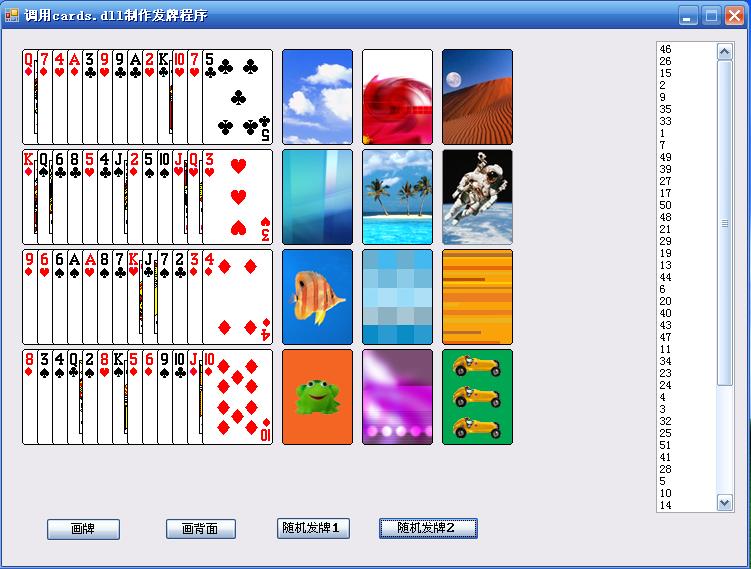本文實例講述了C#編程調用Cards.dll實現圖形化發牌功能。分享給大家供大家參考,具體如下:
using System;
using System.Collections.Generic;
using System.ComponentModel;
using System.Data;
using System.Drawing;
using System.Text;
using System.Windows.Forms;
using System.Runtime.InteropServices;
using System.Windows.Forms.Design;
namespace GetCards
{
public partial class Form1 : Form
{
[DllImport("cards.dll")]
public static extern bool cdtInit(ref int width, ref int height);
[DllImport("cards.dll")]
public static extern void cdtTerm();
[DllImport("cards.dll")]
public static extern bool cdtDraw(IntPtr hdc,int x,int y,int card,int mode,long color);
//mode=0表正面,1表反面,Color我從0-0xFF000試了很多,好象沒顏色改變
//[DllImport("cards.dll")]
//public static extern bool cdtDrawExt(IntPtr hdc,int x,int y,int dx,int dy,int card,int type,long color);
//[DllImport("cards.dll")]
//public static extern bool cdtAnimate(IntPtr hdc,int cardback,int x,int y,int frame);
int[] bb = new int[100];
public Form1()
{
InitializeComponent();
}
private void Form1_Load(object sender, EventArgs e)
{
int width, height;
width = 0; height = 0;
cdtInit(ref width, ref height);
}
private void btn_PaintCard_Click(object sender, EventArgs e)
{
int i, k, left_x, top_y, CardId;
for (k = 0; k <= 3; k++)
{
for (i = 1; i <= 13; i++)
{
left_x = 20 + (i - 1) * 15; //牌的重疊后的寬度是15
top_y = 20 + k * 100; //每行13張牌.高度是20
CardId = (i - 1) * 4 + k; //原來52張牌是編了號的
cdtDraw(this.CreateGraphics().GetHdc(), left_x, top_y, CardId, 0,9);
}
}
}
private void Form1_FormClosed(object sender, FormClosedEventArgs e)
{
cdtTerm();
}
private void btn_PaintBack_Click(object sender, EventArgs e)
{
int i, left_x, top_y, BackId;
for (i = 0; i <= 11; i++) //12張牌背面圖
{
BackId = i;
top_y = 20 + (i & 3) * 100; //小于等于3的不變,>3的截尾,相當于豎排
left_x = 20 + (i >> 2) * 80 + 180 + 80; //左邊牌占15*12+80=260,也就是和最右張牌20(隱含了牌大小=80)
cdtDraw(this.CreateGraphics().GetHdc(), left_x, top_y, 54 + BackId, 1, 9);
}
}
private void btn_Random1_Click(object sender, EventArgs e) //第一種方法實現隨機交換牌
{
int ii, k, left_x, top_y, CardId;
int[] theArray = new int[52];
Random r = new Random();
listBox1.Items.Clear();
for (int i = 0; i < 52; i++)
{
theArray[i] = i + 1;
}
for (int i = 0; i < 52; i++) //就是做52次隨機交換兩張牌
{
int a = r.Next(52); //生成0--->51的隨機數
int b = r.Next(52);
int tmp = theArray[a];
theArray[a] = theArray[b];
theArray[b] = tmp;
}
for (int i = 0; i < 52; i++)
{
listBox1.Items.Add(theArray[i]);
k = (int)(i / 13);
ii = i % 13 + 1;
left_x = 20 + (ii - 1) * 15;
top_y = 20 + k * 100;
CardId = theArray[i] - 1;
cdtDraw(this.CreateGraphics().GetHdc(), left_x, top_y, CardId, 0, 9);
}
}
private void btn_Random2_Click(object sender, EventArgs e) //第一種方法實現隨機交換牌
{
int ii, k, left_x, top_y, CardId;
int[] theArray = new int[52];
int i = 0;
while (i < theArray.Length)
{
theArray[i] = ++i;
}
Random r = new Random();
listBox1.Items.Clear();
while (i > 1) //從51-->1依次隨機向前交換獲得最終值
{
int j = r.Next(i);
int t = theArray[--i];
theArray[i] = theArray[j];
theArray[j] = t;
}
for (i = 0; i < theArray.Length; ++i)
{
listBox1.Items.Add(theArray[i].ToString());
k = (int)(i / 13);
ii = i % 13 + 1;
left_x = 20 + (ii - 1) * 15;
top_y = 20 + k * 100;
CardId = theArray[i] - 1;
cdtDraw(this.CreateGraphics().GetHdc(), left_x, top_y, CardId, 0, 9);
}
}
}
}
界面設計的話截圖比貼Designer.cs省事多了:


更多關于C#相關內容感興趣的讀者可查看本站專題:《C#圖片操作技巧匯總》、《C#常見控件用法教程》、《WinForm控件用法總結》、《C#數據結構與算法教程》、《C#面向對象程序設計入門教程》及《C#程序設計之線程使用技巧總結》
希望本文所述對大家C#程序設計有所幫助。
【網站聲明】本站部分內容來源于互聯網,旨在幫助大家更快的解決問題,如果有圖片或者內容侵犯了您的權益,請聯系我們刪除處理,感謝您的支持!
